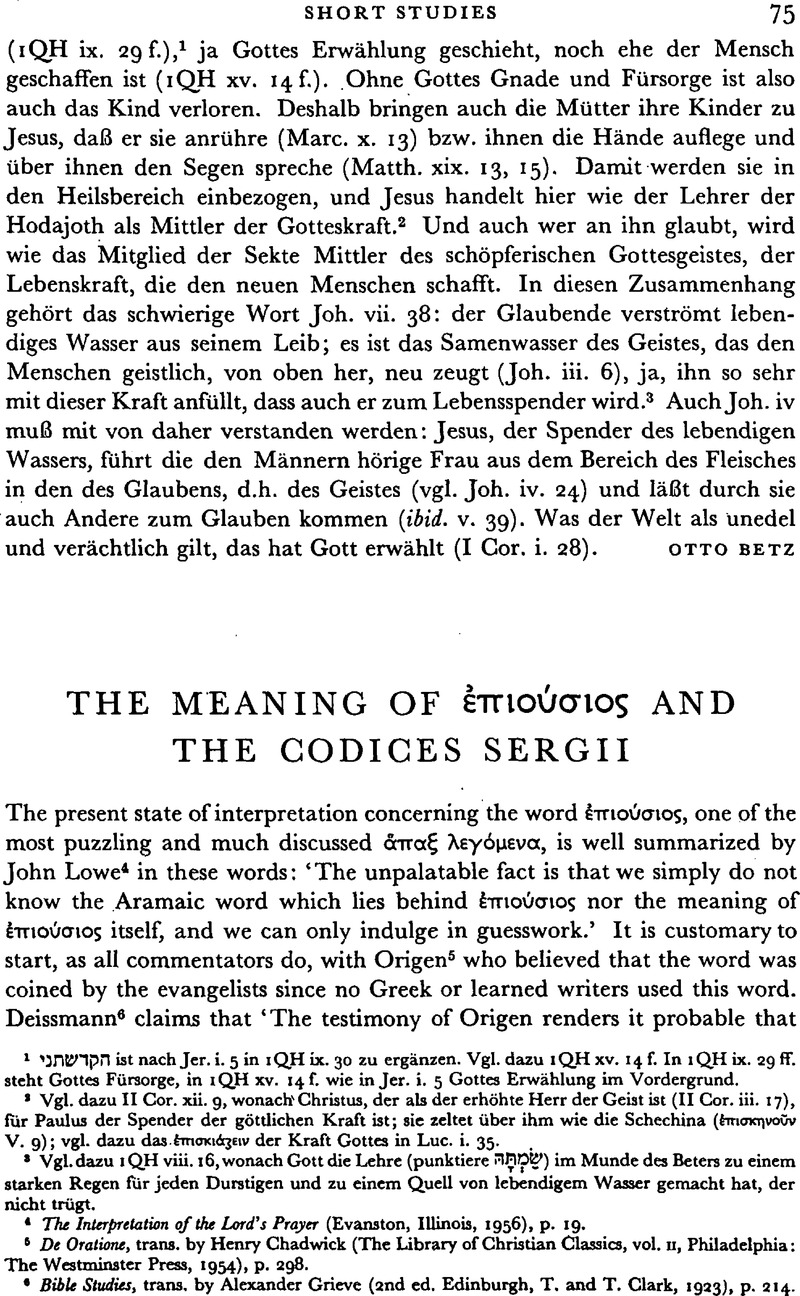No CrossRef data available.
Article contents
The Meaning of έπιούσιος and the Codices Sergii
Published online by Cambridge University Press: 05 February 2009
Abstract

- Type
- Short Studies
- Information
- Copyright
- Copyright © Cambridge University Press 1958
References
page 75 note 1 ![]() ist nach Jer. i. 5 in iQH ix. 30 zu erganzen.Vgl. dazu iQH xv. 14 f. In iQH ix. 29 ff.steht Gottes Fiirsorge, in iQH xv. 14!. wie in Jer.i. 5 Gottes Erwahlung im Vordergrund.Google Scholar
ist nach Jer. i. 5 in iQH ix. 30 zu erganzen.Vgl. dazu iQH xv. 14 f. In iQH ix. 29 ff.steht Gottes Fiirsorge, in iQH xv. 14!. wie in Jer.i. 5 Gottes Erwahlung im Vordergrund.Google Scholar
page 75 note 2 Vgl. dazu II Cor. xii. 9, wonach1 Christus, der als der erhohte Herr der Geist ist (II Cor. iii. 17)fur Paulus der Spender der gottlichen Kraft ist; sie zeltet uber ihm wie die Schechina (![]() ); vgl. dazu das.
); vgl. dazu das.![]() der Kraft Gottes in Luc. i. 35Google Scholar
der Kraft Gottes in Luc. i. 35Google Scholar
page 75 note 3 * Vgl. dazu ) QH viii. 16, wonach Gott die Lehre (punktiere![]() ) im Munde des Beters zu einem starken Regen fur jeden Durstigen und zu einem Quell von lebendigem Wasser gemacht hat, der nicht triigt.Google Scholar
) im Munde des Beters zu einem starken Regen fur jeden Durstigen und zu einem Quell von lebendigem Wasser gemacht hat, der nicht triigt.Google Scholar
page 75 note 4 The Interpretation of the Lord's Prayer (Evanston, Illinois, 1956), p. 19.Google Scholar
page 75 note 5 De Oratoine, trans. by Chadwick, Henry (The Library of Christian Classics, vol. ii, Philadelphia: The Westninster Press, 1954), p. 298.Google Scholar
page 75 note 6 Bible Studies, trans. by Grieve, Alexander (2nd ed.EdinburghT. and T. Clark, 1923), p. 214.Google Scholar
page 76 note 1 Handbuch zu den Apokyrphen des Alten Testaments, IV (Leipzig, 1857), 35.Google Scholar
page 76 note 2 ‘I. έπινοέω, έπινοια and allied words. II έπιούσιος’, J. Theol. Stud. XXXV (1934), 377.Google Scholar
page 76 note 3 ‘How many times does “Epiousios” occur outside the Lord' Prayer?’, Expository Times LXXIX (1957–1958), 52–54.Google Scholar
page 76 note 4 F. Ll. Griffith in his obituary notice on Sayce, A. H. (in J. Egyptian Arch. XIX (1933), 66)Google Scholar describes him in these words: ‘Quick and generous in reconition of merit in younger men, he was impatient of the claims, the pride and the reticence of exact scholarship. He was himself quite accustomed to making mistakes ….’ Cf. Tod, Marcus N., ‘Our Daily Bread’ Church Quart. Rev. CLVIII (1957), 49–51,Google Scholar for an evaluation and criticism of the two documents where έπιούσιος is supposedly mentioned. Cf. also the notes on Origen, De Oratione, XXVII, 7, by Henry CHadwick (L.C.C. II), 362.
page 77 note 1 Metzger, op. cit. pp. 53–4.Google Scholar
page 77 note 2 Liddell and Scott (Greek-English Lexicon, new edition, I, 623) provide the following information: in έπιόψομαι, ι is not elided before a vowel; also some words where σ or has been lost, as έπιάλμενος, έπιεíκελος, έπιεικής, έπιέξομαι.Google Scholar
page 77 note 3 Origen, op. cit. p. 299.Google Scholar
page 78 note 1 Origen, op. cit. p. 302.Google Scholar
page 78 note 2 John of Damascus, De Fide Orthodoxa, trans. Salmond, S. D. F., (Nicene and Post-Nicence Fathers, 2nd ser. IX, New York, 1899), p. 84.Google Scholar
page 78 note 3 Allen, Willoughby C., A Critical and Exegetical Commentary on the Gospel according to S. Matthew (New York, 1925), p. 59.Google Scholar
page 78 note 4 Chase, F. H., The Lord' Prayer in the Early Church (Texts and Studies, ed. Robinson, J. Armitage, Cambridge, 1891), p. 39 n. 1.Google Scholar
page 78 note 5 Cf. Kahle, PaulThe Cairo Geniza (London, 1947), pp. 117–32 and 179–97 for a discussion on the Targum wher he states, ‘We have to regard most of the material collected by Dalman on this problem [‘identifying the special Armaic idion spoken in the time of Jesus’], if not as worthless, yet certainly as misleading’ (p. 131). There is also a section on the Peshitta which in his words is ‘another paralled to the history of the Targums …’ (p. 179). Another work in this field is Harris Birkeland' little volume on The Language of Jesus (Oslo, 1954), where he takes the extreme view (and maybe the right one) that ‘the language of the common people in Palestine in the time of Jesus was Hebrew … that Jesus really used Hebrew’ (p. 39).Google Scholar
page 78 note 6 An Aramaic Approach to the Gospels and Acts (2nd ed. Oxford, Clarendon Press, 1954), pp. 149–53.Google Scholar
page 79 note 1 ‘έπιούσιος in Hebrew and Aramaic’, Expository Times, XXI (1909–1910), 43.Google Scholar
page 79 note 2 Op. cit. p. 214.Google Scholar
page 79 note 3 Zeitschrift (1899), p. 157.Google Scholar
page 79 note 4 Op. cit. p. 377.Google Scholar
page 81 note 1 Eb. Nestle (Encyclopaedia Biblica, pp. 2819–20) states: ‘The oldest tradition seems to be that represented in syrVI (cur., sin. and Acts of Thomas) by, (our) constant, continual bread. This is, in the Pesh. of the OT, the regular rendering of Heb.; see especially Num. iv. 7,(“continual bread” EV), and it is a strange coincidence, that not only the Armenian version of 2 Macc. translated i. 8 (προεθήκαμεν τούς άρτους) by the same word as in NT τόν άρτον ήμν τόν έπιούσιον but also the medieval Jew, Shemtob ben Shaphrut, to whom is due the Hebrew translation of the Gospel of Metthew, published in the 16th century by Münster and Mercier, and republished in 1879 by Ad. Herbst, hit upon the corresponding Hebrew word, translating. He even formed from an adjective, which in biblical Hebrew is as unheard of as έπιούσιοέπιοσα.’Google Scholar


